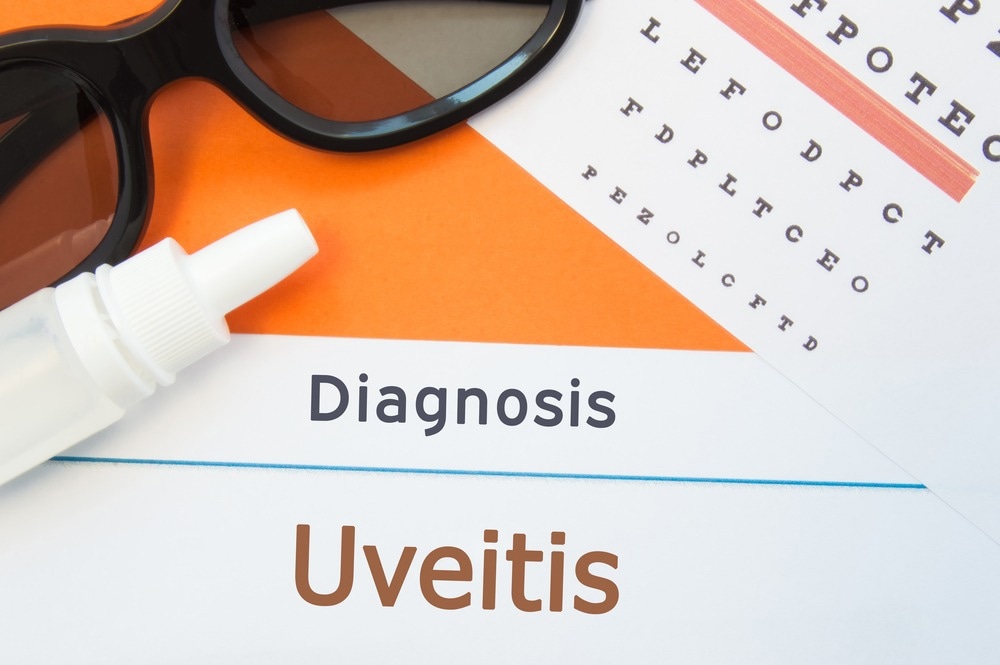In a recent study published in The American Journal of Pathology, researchers provided an overview of existing research on the correlation between uveitis and gut dysbiosis.

Study: The Microbiome and Uveitis: A Narrative Review. Image Credit: Shidlovski/Shutterstock.com
Background
Uveitis is a rare eye condition that can cause significant morbidity. The causes and triggers of the condition, which can lead to blindness, are often unknown.
The primary treatments for uveitis are immunomodulatory agents and corticosteroids. Disease recurrence is still common despite recent therapeutic advances, including biological agents, and controlling the disease can be challenging.
Ongoing research is necessary to understand the mechanisms involved in uveitis pathogenesis, which could potentially lead to the identification of new therapeutic targets.
Potential mechanisms associating gut microbiome and autoimmune uveitis
The concept of molecular mimicry: Autoreactive T-cells can develop in response to mimicker antigens detected in the gut microbiome, leading to molecular mimicry against self-antigens.
Autoreactive T-cells develop against host antigens when the immune system identifies certain antigens as foreign. Intestinal contents transported to experimental autoimmune uveitis (EAU) lymph nodes activated T-cells in an in vitro study.
These T-cells can elicit uveitis when inoculated in wild-type mice intraperitoneally. This supports the hypothesis that intestinal contents contain antigens that activate ocular structures.
The imbalance between effector T-cells and regulatory T-cells: Antigen-presenting cells in the gut lymphatics trigger an inflammatory response by presenting pathologic antigens and activating Th1 and Th17.
The two cell types work together to maintain immune homeostasis. Dysbiosis can cause an imbalance that increases proinflammatory T-cells, which can result in extraintestinal inflammatory conditions like uveitis.
Elevated intestinal permeability: Lipopolysaccharides (LPS) and other microbial products can cause inflammation or worsen autoimmune diseases if they spread outside the intestines.
Dysbiosis may result in a compromised intestinal barrier, leading to the translocation of bacteria or their byproducts through the vascular system.
Exposure to antigens that imitate host cells can either directly cause inflammation or enhance auto-sensitization.
Production of microbial metabolites: Short-chain fatty acids (SCFA) produced by intestinal bacteria is believed to have anti-inflammatory properties.
SCFAs also alleviate inflammatory diseases by balancing regulatory and effector T-cells. SCFAs promote immune tolerance in the gut lymphatic tissues by suppressing Th1/Th17 cells and inducing regulatory T-cells.
The impact of the microbiome on autoimmune uveitis
The spontaneous and induced models of EAU have been utilized to investigate changes in the gut microbiome linked to uveitis, with these being the two primary mouse autoimmune uveitis models.
The induced model uses active immunization with inter-photoreceptor retinoid-binding protein (IRBP), a retinal protein, to trigger an autoimmune reaction against the host retina.
Oral broad-spectrum antibiotics administered one week before immunization reduced uveitis severity compared to water-treated mice in the induced EAU model. The study found that intraperitoneal antibiotic treatment did not reduce uveitis or affect gut microbial load.
This suggests that changes in the gut microbiome may cause the condition instead of a direct anti-inflammatory influence of the antibiotics. Metronidazole and other antibiotics have immunosuppressive properties.
Antibiotic treatment increased intestinal regulatory T-cells at two weeks and extraintestinal regulatory T-cells at three and four weeks post-treatment.
Other studies have achieved similar results through various antimicrobial treatments and inoculation in germ-free environments. Germ-free mice are bred and raised in sterile environments to avoid microbial contamination.
New colonies and strains are established through a sterile cesarean section and then moved to a germ-free environment. Treating one week before, and not during, disease development depressed inflammation.
The study suggests that the preexisting gut microbiome in mice plays a crucial role in disease induction instead of serving as an alternative route for reducing inflammation due to antibiotic treatment.
When administered orally separately, Metronidazole and vancomycin showed a reduction in uveitis in the induced model. However, ampicillin and neomycin did not have the same effect. Ampicillin and neomycin had contrasting effects on the production of regulatory T-cells and did not reduce uveitis when used separately.
Vancomycin and metronidazole treatment reduced the levels of Dorea, Coprococcus, Adlecreutzia, Clostridium, and Lactobacillus species in the gut microbiome, which are correlated to uveitis development and may be potential sources of mimicker antigens.
Conclusion
The study findings noted a clear connection between uveitis and the intestinal microbiome. The gut microbiome is known to be altered in disease states based on human studies, and animal models have shown that dysbiosis is a causal factor of autoimmunity rather than only an association.
More research is needed to apply this insight to clinical settings. Clinical evidence does not support the potential benefits of supplementation with microbial metabolites like SCFAs. Future longitudinal patient studies will be necessary to establish their effectiveness.